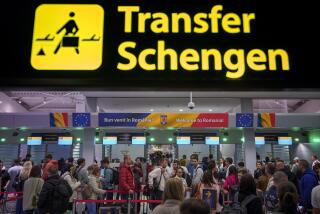EU Plan Will Extend Duty-Free Access to Third World Exports
- Share via
BRUSSELS — European Union governments on Tuesday hailed their agreement on a pioneering plan to allow duty-free access to its markets for virtually all products from the world’s poorest countries.
“This is a global first,” said a triumphant EU Trade Commissioner Pascal Lamy after foreign ministers adopted his hard-won proposal after five months of debate.
The pledge, which applies to all products except military weapons from 48 indigent nations, imposes fresh pressure on the Bush administration to adopt more generous trade policies toward developing nations.
The “Everything but Arms” proposal is part of Lamy’s strategy of winning over developing countries to support a new round of global trade liberalization talks after their opposition helped sink attempts to do so in Seattle in 1999.
But some critics said there was less than meets the eye to the EU agreement. Michael Finger, lead economist in the trade policy group at the World Bank, speaking for himself and not the bank, bluntly derided the announcement as “the EU taking a bow for something that other developing countries will be providing.”
That’s because for the most part, the increased exports to the European Union from the poorest countries will substitute for exports from less-poor developing nations, rather than displacing production in Europe itself.
The European Union is already the biggest importer of goods from the poorest countries, drawing in nearly $8 billion worth, or more than half, of their total exports. The new plan will extend duty-free access to an additional $70 million worth of products.
U.S. Trade Representative Robert B. Zoellick on Tuesday welcomed the EU move, noting that Washington’s own provision of low tariffs for developing countries, the Generalized System of Preferences, is up for congressional renewal this year. The provision allows duty-free access to exports from many poor nations, but it contains a number of exceptions such as an exclusion for textiles and apparel.
More to Read
Sign up for Essential California
The most important California stories and recommendations in your inbox every morning.
You may occasionally receive promotional content from the Los Angeles Times.










